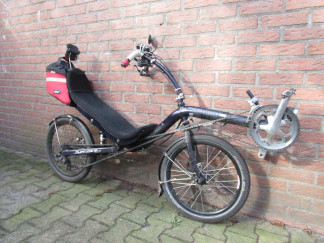
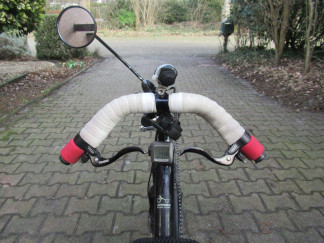
This is my Challenge Hurricane that I bought second hand back in 2010 or 2011. I think it is the Tour version because the swingarm seems longer than others I have seen. It is probably the small version because the front boom is extended nearly as far as possible and I am about 173 cm. The bike probably would not fit people much larger than I am.
This bike is the one I ride to work in the winter and rain. I thought it appropriate to document it in its dirty and gritty state at the end of the winter. Sometime during the summer I will clean everything and make it ready for next year.
I have made numerous changes and modifications to the bike which I will describe here. My intention is that other owners of Challenge Hurricanes can learn from my experiences and make good, informed choices. Searching for replacement parts like idlers and choosing good gearing can be difficult without experience with recumbents. I have collected a couple of links here to things that have worked for me.
The bike has had numerous drivetrain configurations over the years. It started out as a Shimano RSX 3x9 system with a long rear cage and twist shifters. The front is still mounted but not connected to a shifter. I had tried removing it but occasionally the chain would fall off the big ring when going over bumps. That was with a regular (without clutch) derailleur. Possibly it would not be necessary if a rear derailleur with a clutch was used or with a narrow-wide chainring.
I have previously had a Shimano LX rapid-rise rear derailleur which excellent once you get used to the shifting pattern. The rapid-rise has disappeared from modern derailleurs but my experience was very positive. It makes much more sense to easily click up a few gears while braking and be immediately in a good gear to accelerate from a stop. If I could find a rapid-rise system with a short cage that worked with 10-speeds I would probably still be using it.
The bike has also had a SRAM apex short-cage as a 1x10 system. The shifters allows much more flexibility in how they are placed. They could be moved slightly to the right (compared to the Shimano ZEE in the picture) and angled better for shifting with your thumbs. This is done by adding a few washers and a longer mounting bolt. Overall this was probably the best shifting system I have ever had on any bike.
Currently, I have a Shimano Zee 1x10 system with a (Shimano) 12-27 at the back and 53 tooth up front. The Zee has a clutch which is supposed to reduce chain-slap from the very long chain, but I don't really notice either way. It has just low enough gears for quick acceleration and getting up a steep viaduct or bridge, and very nearly high enough gears on the flat when there is a tail wind. At the same time it has quite a few 1-tooth differences in the flat-cruising range to get exactly the cadence you want. Very occasionally you would want a higher gear but then you are already going 45-48 km/hr and you should ask yourself if it is really necessary to go much faster on your commuter. If the terrain was hilly, the gear range would probably be borderline or inadequate, but its perfect for flat north of the Netherlands where I live.
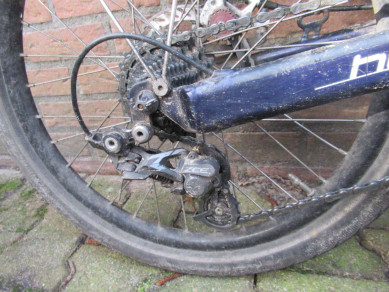
The Shimano Zee shifter is mounted on the steering tiller up close to the handlebars. You have to really stretch open the mount on the Zee to get it mounted, but you only do that once so it should be OK. You shift with your right thumb.
When the drivetrain wears out I will probably consider going to a (SRAM) 12-28 with a 54 tooth (probably a narrow-wide) at the front.This gives pretty much the same low gear as before and just a bit higher top gear. It may also make it possible to lose the front derailleur for a cleaner look.
Going to a short-cage rear derailleur is not a simple thing with the Hurricane. The idea was to get the lower wheel up off of the ground and out of the spray from the front wheel. Take a good look at recumbents with 406 wheels and a long-cage derailleur. The lower wheel is just a few centimeters from the ground.
With the original chainline, the short-cage causes chainline conflicts with the swingarm and frame on the return side. I rigged something up from the old mounting points using two slightly modified disc brake adapters, a strip of aluminium, and a couple of zipties. This moves the return idler lower and more forward than its previous position. I wonder if the guy who invented zipties would see this and either be horrified or proud of me. Anyway this system has held up over several winters with no problems at all so it is certainly an adequate solution.
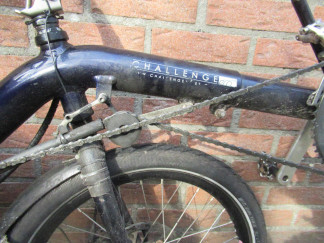
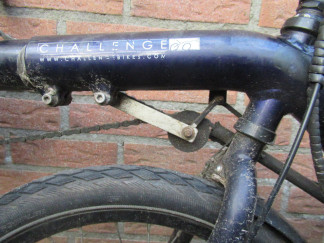
I have replaced the power-idler and the return idler when the old ones wore out. The power-idler has a metal gear in the middle which probably makes it more efficient but it is certainly noisier than the old one which had O-rings. The new one was a direct drop-in replacement with the old one and worked perfectly.
The bike originally has AVID BB5 mountain-bike brakes with big AVID Speed-Dial levers mounted on top of the handlebars in the usual way for recumbents. The BB5 were occasionally perfect but needed frequent adjustment, and when the worked poorly they were horrible.
I had first changed the calipers to BB7 road and the levers to Cane Creek Crosstop mounted “backwards” at the end of the bar. This way you brake with your thumbs and the levers are completely out of your line of sight. The cables run along the handlebar, take a short turn at the tiller and down to the rest of the bike. I also took a few cm off of the handlebar ends as they aren't used anymore.
I have since replaced the front BB7 with a TRP-Spyre which I had over from conversion from another bike. The TRP-Spyre works very well, at least as well as the BB7. It also looks cleaner, being much more hidden behind the fork compared to the BB7 which sticks out a bit. The feel at the lever is perfect with the Crosstop calipers. I have had no problems at all with them after mounting then more than a year ago.
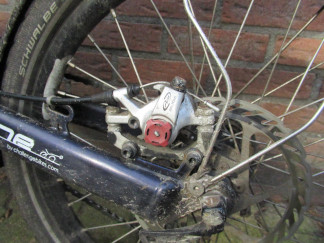
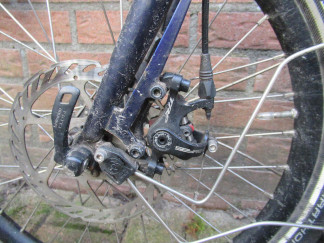
Overall, having powerful disc brakes on a bike with a low center of gravity, 406 wheels and wide tires gives extremely good braking.
I have used Schwalbe Kojak 406-35 for a while which are very nice but not ideal for gritty conditions. Grip is surprisingly good in the cold and even in the rain, much better than you might expect from the slicks. This is probably due to the soft compound and flexible sidewall. The downside is the soft compound means they wear out fairly fast and they become sensitive to flats when the rubber gets thin.
Currently I have Schwalbe Marathon 406-47 Greenguard tires and they are the exact opposite of the Kojaks. Pumped up they feel like wood and don't roll as well as you might expect for a wide tire. They also become wiggly when slightly leaned over, this is probably due to the contact patch being just beside the central ridge. But they do last an extremely long time and I have never had a flat when using them. This makes them good tires for a commuter.
The rear bag is a Radical design Aero. It is not very large but you can still get quite a bit of clothes in there by stuffing it in.
The bike originally had a closed-cell foam seat pad. This was OK in the winter but really sweaty in the summer. I replaced it with one from Ventisit which is just perfect. You can really feel the ventilation and it does not feel at all "squishy" as I had expected. It does not feel cold in the winter probably because it keeps your back from getting wet from sweat.
The cranks have been changed to a Ultegra 165 mm which I found on Marktplaats. I prefer 165 mm cranks as they give a higher cadence and feel easier on my knees. I used to have a mountain bike with 175 mm cranks and it always felt like my knee had too much bend at the top of the pedal stroke and too much rotation in the hips to keep my lower back stable while pedaling. The 165 mm are nicer for me to find a good rhythm.
Douglas Eleveld
deleveld@dds.nl